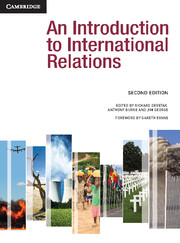Book contents
- Frontmatter
- Contents
- Tables, Figures and Boxes
- Contributors
- Preface and acknowledgements
- An Introduction to International Relations: The origins and changing agendas of a discipline
- 1 Theories of International Relations
- 2 The Traditional Agenda
- 9 The Modern State
- 10 Nations and Nationalism
- 11 Security
- 12 Arms Control
- 13 The Causes of War
- 14 The Changing Character of Warfare
- 15 The Ethics and Laws of War
- 16 International Law
- 17 International Society and European Expansion
- 18 Diplomacy
- 19 Great Powers
- 20 The Cold War
- 3 The New Agenda
- Glossary of Terms
- Bibliography
- Index
- References
19 - Great Powers
from 2 - The Traditional Agenda
- Frontmatter
- Contents
- Tables, Figures and Boxes
- Contributors
- Preface and acknowledgements
- An Introduction to International Relations: The origins and changing agendas of a discipline
- 1 Theories of International Relations
- 2 The Traditional Agenda
- 9 The Modern State
- 10 Nations and Nationalism
- 11 Security
- 12 Arms Control
- 13 The Causes of War
- 14 The Changing Character of Warfare
- 15 The Ethics and Laws of War
- 16 International Law
- 17 International Society and European Expansion
- 18 Diplomacy
- 19 Great Powers
- 20 The Cold War
- 3 The New Agenda
- Glossary of Terms
- Bibliography
- Index
- References
Summary
Introduction
One of the fundamental characteristics of any international system is the distribution of power among states. The sheer fact that states are unequal in terms of power entails a number of important implications for international politics. For example, while the desires and concerns of weak states are often neglected, the demands of strong states usually shape the international agenda; relations among strong states, in turn, significantly affect patterns of international stability, order and change. In short, if you want to shed light on some basic dynamics of international affairs, for analytical or practical purposes, always ask yourself a set of very simple questions: how is power distributed among states? Who are the strong states? How do they stand vis-à-vis each other? Although the relationship of forces is by no means the only explanatory variable at play, it frequently goes a long way in accounting for the ‘who gets what, when and how’ on the international stage.
What we have generically called ‘strong states’ are often referred to as ‘great powers’. At first sight, the definition of ‘great power’ seems unproblematic. After all, do we not know who are the great powers today? And do we not know who were the great powers in, say, the nineteenth century? Do we not recognise a great power when we see one? Yet if we look closer and try to come up with a working definition, things immediately become more complicated. The next section of this chapter will therefore focus on the attributes of a great power, on the elements – or the combination of elements – that allow us to tell a great power from other states. Such a conceptual effort will be followed by a brief historical regression whose purpose is to show the role played by the great powers in the modern and contemporary international systems. Next, we will examine the main theories of international relations that claim to explain broad patterns of cooperation and conflict between great powers. Some emphasise the special functions that great powers perform; some rely on the number of the existing great powers; some identify in the rise and decline of the great powers the basic force behind international change. The last section will assess the relevance of the established knowledge for the post-Cold War international system.
- Type
- Chapter
- Information
- An Introduction to International Relations , pp. 268 - 280Publisher: Cambridge University PressPrint publication year: 2011
References
- 2
- Cited by

